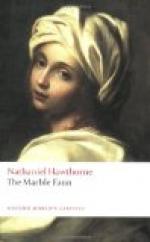The drawing had originally been very slight, and had suffered more from time and hard usage than almost any other in the collection; it appeared, too, that there had been an attempt (perhaps by the very hand that drew it) to obliterate the design. By Hilda’s help, however, Miriam pretty distinctly made out a winged figure with a drawn sword, and a dragon, or a demon, prostrate at his feet.
“I am convinced,” said Hilda in a low, reverential tone, “that Guido’s own touches are on that ancient scrap of paper! If so, it must be his original sketch for the picture of the Archangel Michael setting his foot upon the demon, in the Church of the Cappuccini. The composition and general arrangement of the sketch are the same with those of the picture; the only difference being, that the demon has a more upturned face, and scowls vindictively at the Archangel, who turns away his eyes in painful disgust.”
“No wonder!” responded Miriam. “The expression suits the daintiness of Michael’s character, as Guido represents him. He never could have looked the demon in the face!”
“Miriam!” exclaimed her friend reproachfully, “you grieve me, and you know it, by pretending to speak contemptuously of the most beautiful and the divinest figure that mortal painter ever drew.”
“Forgive me, Hilda!” said Miriam. “You take these matters more religiously than I can, for my life. Guido’s Archangel is a fine picture, of course, but it never impressed me as it does you.”
“Well; we will not talk of that,” answered Hilda. “What I wanted you to notice, in this sketch, is the face of the demon. It is entirely unlike the demon of the finished picture. Guido, you know, always affirmed that the resemblance to Cardinal Pamfili was either casual or imaginary. Now, here is the face as he first conceived it.”
“And a more energetic demon, altogether, than that of the finished picture,” said Kenyon, taking the sketch into his hand. “What a spirit is conveyed into the ugliness of this strong, writhing, squirming dragon, under the Archangel’s foot! Neither is the face an impossible one. Upon my word, I have seen it somewhere, and on the shoulders of a living man!”
“And so have I,” said Hilda. “It was what struck me from the first.”
“Donatello, look at this face!” cried Kenyon.
The young Italian, as may be supposed, took little interest in matters of art, and seldom or never ventured an opinion respecting them. After holding the sketch a single instant in his hand, he flung it from him with a shudder of disgust and repugnance, and a frown that had all the bitterness of hatred.
“I know the face well!” whispered he. “It is Miriam’s model!”




